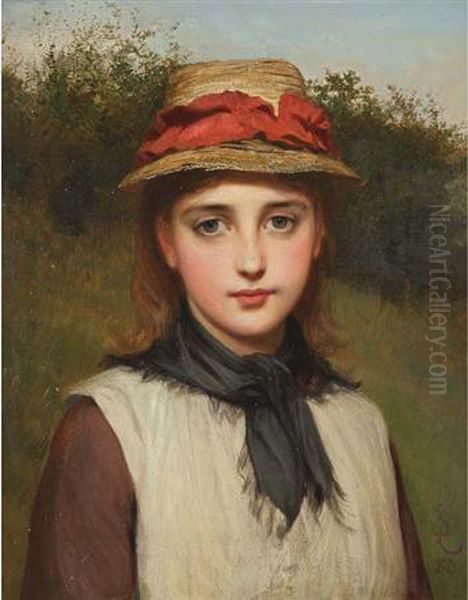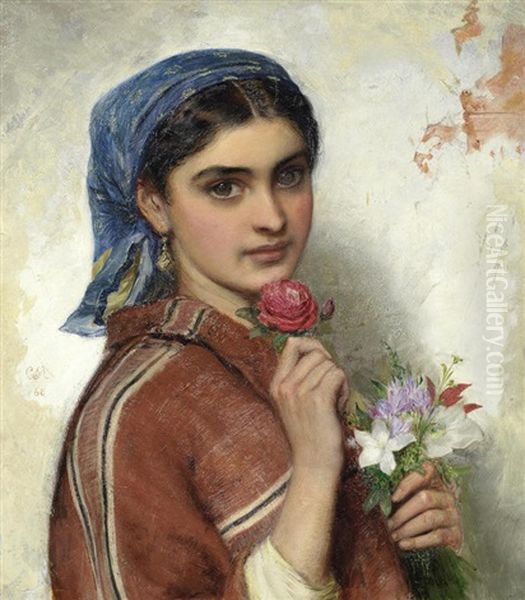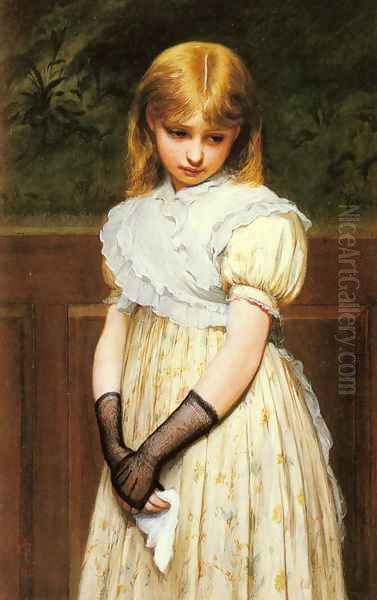Charles Sillem Lidderdale stands as a notable figure within the rich tapestry of British Victorian art. Active during a period of significant artistic production and evolving tastes, Lidderdale carved a distinct niche for himself, primarily celebrated for his charming and elegant depictions of young women, often situated within idyllic rural or outdoor settings. His work captures a particular sensibility of the era, blending technical proficiency with a gentle, often romanticized, view of femininity and rustic life. Understanding Lidderdale requires exploring his life, his artistic development, his specific style, and his place within the broader context of 19th-century British painting.
Early Life and Artistic Formation
Charles Sillem Lidderdale was born not in Britain, but in St. Petersburg, Russia, on September 28, 1830. His father, John Sillem Lidderdale, likely provided an environment where young Charles's artistic inclinations could be nurtured. Sources suggest he displayed a strong interest and natural talent for art from an early age, potentially influenced by his familial surroundings. The family later relocated to England, which would become the primary stage for his life and artistic career.
His formal artistic training took place in London, the vibrant heart of the British art world. Lidderdale enrolled in the prestigious Royal Academy Schools. Here, he would have received a rigorous education grounded in the classical traditions of drawing and painting, honing the technical skills necessary for a successful career. The Royal Academy was the dominant art institution in Britain, and studying within its schools provided aspiring artists with essential training and valuable connections.
The Royal Academy and Career Beginnings
The Royal Academy of Arts played a crucial role throughout Lidderdale's professional life. Graduating from its schools, he began exhibiting his works at the Academy's renowned annual exhibitions. These exhibitions were major events in the London social and cultural calendar, offering artists vital exposure to patrons, critics, and the public. Lidderdale became a regular contributor, showcasing his paintings over several decades.

Between 1856 and 1893, a significant span of his mature career, Charles Sillem Lidderdale exhibited a total of 36 paintings at the Royal Academy. This consistent presence indicates a steady level of production and acceptance within the mainstream art establishment. Exhibiting at the RA was a mark of professional achievement and helped solidify an artist's reputation. Lidderdale's works, focusing on his preferred subjects, found an appreciative audience among the Victorian public.
Artistic Style and Favoured Themes
Lidderdale developed a distinctive and recognizable style characterized by elegance, refinement, and meticulous attention to detail. His primary subject matter revolved around portraits, particularly single figures of young women and girls. These figures were often depicted in outdoor settings – leaning against a rustic fence, pausing by a cottage door, or set against a backdrop of gentle countryside. This connection to nature enhanced the themes of innocence and simplicity often associated with his subjects.
His portrayal of women reflected prevalent Victorian ideals. The figures often possess a demure, contemplative, or slightly wistful air. They are typically dressed in attire that, while sometimes suggesting rural life, is rendered with care, showcasing textures and folds of fabric. Lidderdale demonstrated a sensitive handling of colour and light, contributing to the overall charm and appeal of his compositions. His approach was less concerned with grand historical narratives or overt social commentary, focusing instead on capturing moments of quiet beauty and idealized femininity.
The artist was particularly noted for his depictions of young women embodying purity and rustic grace. Titles like The Farmer's Daughter exemplify this thematic focus. He also painted subjects described as "Gypsy girls," which, while potentially playing into romanticized stereotypes of the era, were praised for their execution and characterization. These works allowed him to explore slightly more unconventional beauty while still maintaining his characteristic polished technique.
Technical Skill and Medium
Lidderdale worked primarily in oils, a medium well-suited to his detailed and polished style. His training at the Royal Academy Schools would have provided a strong foundation in oil painting techniques, enabling him to achieve smooth finishes, subtle modelling of forms, and rich colouration. His careful rendering of fabrics, hair, and facial features demonstrates considerable technical skill.
Interestingly, Lidderdale also worked in watercolour. However, his career faced a significant challenge due to deteriorating eyesight. He suffered from an eye condition that threatened his ability to paint. Fortunately, he received treatment from an oculist named Tyrwhitt-Twidi, which allowed him to continue working for a time.

Despite this medical intervention, the strain of detailed work eventually took its toll. Lidderdale found watercolour, which often requires greater precision and control, particularly demanding on his failing vision. Consequently, he was forced to largely abandon this medium later in his career, concentrating instead on oil painting, which perhaps offered slightly more latitude. This adaptation in the face of physical adversity highlights his dedication to his art.
Representative Works
Several paintings stand out as representative of Charles Sillem Lidderdale's oeuvre. The Farmer's Daughter encapsulates his interest in idealized rural femininity. The Flower Seller likely presented a charming figure engaged in a picturesque occupation, a popular theme in Victorian genre painting. Another notable work mentioned is Petulance, suggesting a study in expression and mood, perhaps depicting a moment of youthful pique or contemplation.
His paintings often featured titles that hinted at a gentle narrative or emotional state, such as In Disgrace, a watercolour whose title suggests a story behind the image. Works like A Young Girl and her Dog at a Garden Door combine his interest in youthful figures with the charm of domestic animals and picturesque settings. The recurring motif of young women, often with thoughtful or slightly melancholic expressions, rendered with delicate precision, defines his contribution.
Lidderdale in the Context of Victorian Art
To fully appreciate Lidderdale's work, it's helpful to place him within the broader context of Victorian art. The 19th century in Britain saw a diverse range of artistic styles and movements. The Royal Academy, where Lidderdale consistently exhibited, largely championed traditional approaches to painting, favouring polished finishes, clear narratives, and morally uplifting or aesthetically pleasing subjects.
Lidderdale worked contemporaneously with the Pre-Raphaelite Brotherhood (PRB) and their followers, though his style differs significantly. Artists like Dante Gabriel Rossetti, Sir John Everett Millais, and William Holman Hunt sought a return to the perceived purity and detail of early Renaissance art, often tackling complex literary, religious, or symbolic themes with intense detail and vibrant colour. Lidderdale's work, while detailed, generally lacked the symbolic weight or the sometimes stark realism found in early PRB works.
His focus on idealized female beauty aligns him more closely with other popular Victorian painters who specialized in genre scenes and elegant portraiture. Figures like Lord Frederic Leighton and Sir Lawrence Alma-Tadema, leading figures of the High Victorian era, also depicted beautiful women, often in classical or opulent settings, showcasing technical virtuosity. While Lidderdale's settings were typically more rustic, the shared emphasis on aesthetic refinement provides a point of comparison.

Other contemporaries explored different facets of Victorian life. William Powell Frith captured bustling modern scenes like Derby Day or The Railway Station. James Tissot, though French, spent a significant part of his career in London, painting fashionable society with elegance and psychological nuance. Genre painters like Frederick Morgan specialized in charming, often sentimental, scenes of childhood and rural life, sharing some thematic ground with Lidderdale, though perhaps with a more overtly narrative or anecdotal approach.
Painters like John William Waterhouse, active towards the end of Lidderdale's life, continued the interest in female figures but often drew inspiration from myth and legend, bridging Victorianism and later Symbolist trends. Artists such as George Frederic Watts pursued more allegorical and monumental themes, while figures like Arthur Hughes, associated with the Pre-Raphaelites, brought a gentle poetry to his depictions of romance and nature. Female artists like Sophie Gengembre Anderson also gained recognition for their charming depictions of children and rural life, sometimes overlapping thematically with Lidderdale's focus. Lidderdale's contribution sits comfortably within this diverse landscape as a consistent producer of graceful, well-executed images that appealed to Victorian tastes for beauty, sentiment, and technical skill.
Reception, Popularity, and Legacy
During his lifetime, Charles Sillem Lidderdale achieved a respectable level of success and recognition. His regular inclusion in the Royal Academy exhibitions attests to his standing within the art establishment. His paintings found favour with the public and collectors, particularly, it is noted, in the Midlands region of England. This suggests his particular brand of idealized portraiture resonated well with provincial tastes and collecting habits.
Many of his works entered private collections, which is common for artists specializing in easel paintings of this nature. While perhaps not reaching the fame or critical acclaim of the absolute leading figures of the era, Lidderdale maintained a steady career and produced a body of work appreciated for its charm and technical competence. His paintings offered an escape into a world of gentle beauty and quiet contemplation, aligning with certain Victorian desires for art that was pleasing and reassuring.
His legacy lies in his contribution to the specific genre of idealized female portraiture within the broader Victorian context. His works serve as documents of the aesthetic preferences and, to some extent, the social ideals of the time, particularly concerning the representation of femininity. He persevered in his art despite significant personal challenges, leaving behind a collection of paintings that continue to appeal for their delicate beauty and skilled execution.
The Art Market Today

Charles Sillem Lidderdale's works continue to appear on the art market, primarily through auctions. His paintings generally command prices reflective of a competent and recognized Victorian artist, though typically not reaching the levels of the era's superstars. The value depends on factors such as the size, subject matter, condition, provenance, and medium of the specific piece.
Auction records provide concrete examples of his market presence. In late 2021, a watercolour titled In Disgrace was offered by Claydon Auctioneers with an estimate of £4,000–£5,000, indicating significant value placed on a well-regarded example, possibly due to its medium (given he produced fewer watercolours later) or specific appeal.
More recently, oil paintings have appeared at auction. In September 2022, Parker Fine Art Auctions sold A Young Girl and her Dog at a Garden Door within an estimate of £800–£1,200. In October 2024, CRN Auctions offered a portrait of a girl in a red headscarf with an estimate of $800–$1,200. These figures suggest a consistent, if modest, market for his oil paintings, placing them within reach of collectors of Victorian art who appreciate his specific style and subject matter. His works are valued for their decorative quality and representation of Victorian aesthetics.
Conclusion: An Enduring Victorian Charm
Charles Sillem Lidderdale (1830-1895) occupies a specific and honourable place in the history of 19th-century British art. Born in Russia but trained and based in London, he became a specialist in portraying the grace and perceived innocence of young women, often set against simple, natural backdrops. His education at the Royal Academy Schools provided him with a solid technical foundation, evident in the detailed and polished finish of his works.
A regular exhibitor at the Royal Academy for nearly four decades, Lidderdale navigated the Victorian art world with consistency, producing works that found favour with collectors, particularly outside the capital. His dedication is further underscored by his perseverance in painting despite facing deteriorating eyesight, adapting his practice to continue his artistic pursuits.
While perhaps not an innovator on the scale of the Pre-Raphaelites or the grand masters of High Victorian classicism, Lidderdale excelled within his chosen niche. His paintings, such as The Farmer's Daughter and Petulance, offer a gentle, romanticized vision that resonated with the tastes of his time. Today, his works continue to be appreciated for their technical skill, inherent charm, and embodiment of a particular Victorian aesthetic sensibility, securing his legacy as a talented painter of feminine grace.